Happy Thanksgiving from Karen’s Chatt! Wishing each of you a blessed and happy Thanksgiving. May your home be filled with love, happiness, and thankfulness as you gather with family and friends today.
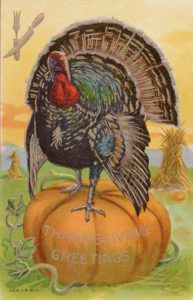

Nov 25
Happy Thanksgiving from Karen’s Chatt! Wishing each of you a blessed and happy Thanksgiving. May your home be filled with love, happiness, and thankfulness as you gather with family and friends today.

Nov 23
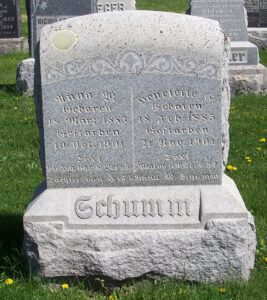
Anna W & Henrietta C Schumm, Zion Lutheran Cemetery, Van Wert County, Ohio. (2012 photo by Karen)
This is the tombstone of Anna W. and Henriette C. Schumm, located in row 8 of Zion Lutheran Cemetery, Schumm, Van Wert County, Ohio. The marker is inscribed:
Anna W.
Geboren
18 Marz 1883
Gestorben
10 Oct 1901
Text
John 8:61
Henriette C.
Geboren
18 Feb. 1885
Gestorben
21 Nov. 1901
Text
Psalm 119:92
Tochter von H.G. u. Anna M. Schumm
SCHUMM
Anna W, born 18 March 1883, died 10 October 1901. Henriette C, born 18 February 1885, died 21 November 1901. Daughter[s] of H.G. and Anna M. Schumm.
Sisters Anna Wilhelmine and Henrietta Clara Schumm were the second and third of five children born to Henry George “H.G.” and Anna M. (Roehm) Schumm. H.G. Schumm (1854-1939) and Anna M. Roehm (1857-1901) married at Zion Lutheran Church, Schumm, on 1 April 1879
Anna Wilhelmine Schumm was born in Willshire Township on 18 March 1883. She was baptized at Zion Schumm on 26 March 1883, with Susanna Roehm, Sophie Schumm, and Mrs. Rev. Seemeyer serving as her sponsors.
Henriette Clara Schumm was born in Willshire Township on 18 February 1885. She was baptized at Zion Schumm on 1 March 1885, with Mrs. Maria Grund and Rosine Schumm serving as her sponsors.
The Henry George Schumm family in 1900: Henry G, 45; Annie M, 43, wife; Amelia, 19, daughter; Annie W, 17, daughter; Henrietta, 15, daughter; Walter E, 11, son; Esther, 6, daughter; Marie Schumm, 79, mother. The father H.G. Schumm was a farmer in Willshire Township. [1]
The following year was a tragic year for the H.G. Schumm family as typhoid fever ravaged the family. H.G.’s 44-year-old wife Anna (Roehm) Schumm died from typhoid fever on 23 September 1901.
Daughter Anna Wilhelmine died in Willshire from typhoid fever on 10 October 1901, at the age of 18 years, 6 months, and 22 days. She was buried on the 25th.
Daughter Henriette Clara died in Willshire from typhoid fever on 21 November 1901, at the age of 16 years, 9 months, and 3 days. She was buried on the 24th.
Widower H.G. Schumm, left with three children at home, married widow Wilhelmina “Mina” (Kroemer) Limecooly (1863-1951) on 23 November 1904. H.G. and Mina did not have any children of their own but Mina (Kroemer) had three children from her marriage to William F. Limecooly (1857-1900). [2]
Sisters Anna Wilhelmine and Henriette Clara Schumm had the following siblings:
Maria Amalia Schumm (1880-1946), married John Henry “Hugo” Schumm
Walter Emanuel Schumm (1888-1967), married Erna Theresa Schumm
Esther Emilie Schumm (1893-1983), married Amos Clemens Schumm
[1] 1900 U.S. Census, Willshire, Van Wert, Ohio, ED 97, p.10, dwelling 193, family 206, Henry G Schumm; digital image by subscription, Ancestry.com, viewed 22 Nov 2021.
[2] Children of William F. & Mina (Kroemer) Limecooly: Edward Frederick (1890-1961); George D. (1893-1972); Mary Margaret (1897-?).
Nov 19
Calling all Weisenborns. For those of you with a Weisenborn connection in your family tree, there is an online worldwide Weisenborn database.
A few months ago I corresponded with family genealogist Toon Weisenborn, from Nordhorn, Germany. Toon has been interested in her family’s Weisenborn genealogy since she was a young girl and she has since set out to gather information about all Weisenborns in Germany, the Netherlands, and around the world.
Because of this interest, Toon has created the website, Project All Weisenborns and Wittenborns, to help Weisenborn researchers. Her website is freely accessible and she will add information and make corrections to the Weisenborn information she has already compiled there.
You may find your Weisenborn family in one of her trees. If not, she offers to add new Weisenborn data to an existing tree or add a new tree when necessary.
Her efforts are a great aid to all Weisenborn researchers.
I do not believe I have any Weisenborns in my family tree but there were and still are Weisenborns in this area.
Luther Weissenborn (1846-1864) is buried in Zion Lutheran Cemetery, Schumm. [1] The John Christoph and Mary Catharine (Schüt) Weisenborn family attended Zion Chatt in the mid-1860s and later. Zion’s records indicate that John Christoph and Mary Catharine were from Niederdorla, Thuringen, and Grossherzogtum, Baden, respectively. Several Weisenborns are buried in Kessler/Liberty Cemetery and several in Hopewell Township’s Friends Cemetery, both cemeteries in Mercer County.
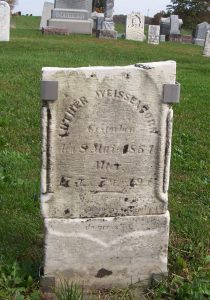
Luther Weissenborn, Zion Lutheran Cemetery, Schumm, Van Wert County, Ohio. (2012 photo by Karen)
I urge Weisenborn researchers to check out Toon’s Weisenborn website. [2]
Enjoy!
[1] Tombstone Tuesday-Luther Weissenborn, Karen’s Chatt, 27 Nov 2018.
[2] Project All Weisenborns and Wittenborns, Toon Weisenborn, https://weisenborn-boer.nl/Weissenborn_Wittenborn/Stambomen/data.htm.
Nov 16
A bird symbol on a tombstone, often depicted as a dove, symbolizes peace, resurrection, and innocence and is often used on a child’s tombstone.
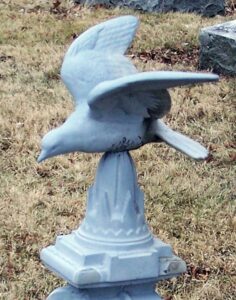
Bird on zinc child’s tombstone.
A dove holding an olive branch symbolizes peace or that the soul has reached divine peace in heaven.
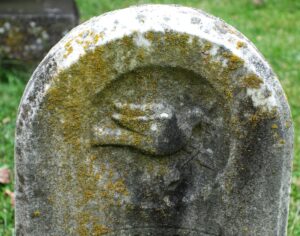
Flying bird with olive branch.
A flying bird symbolizes the winged soul, a tradition dating back to the early Egyptians. An ascending bird represents the transport of the departed’s soul to heaven. A descending bird or dove represents a descent from heaven and the assurance of a safe passage.
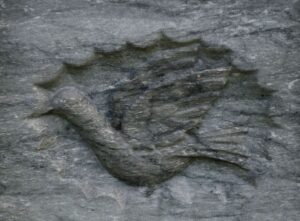
Flying bird symbol.
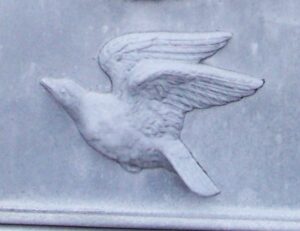
Flying bird symbol on zinc tombstone.
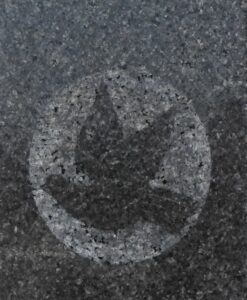
Flying bird symbol.
Birds are sometimes used as part of an organization’s logo, as seen below for logos of the Grand Army of the Republic (GAR), the Knights of Columbus (Roman Catholic fraternal organization), and the 32nd degree Mason.
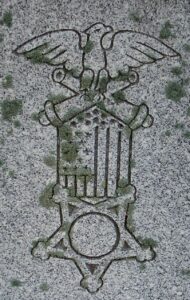
Bird included in GAR logo.
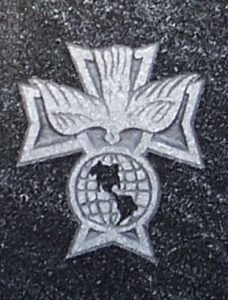
Dove included in Knights of Columbus logo.
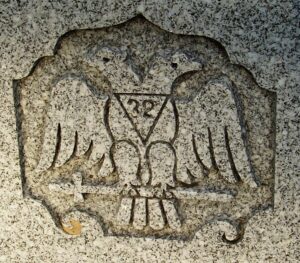
Bird included in 32nd degree Mason logo.
A bird lying dead symbolizes a life that was cut short prematurely.
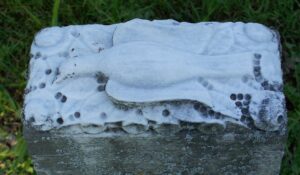
Dead bird symbol.
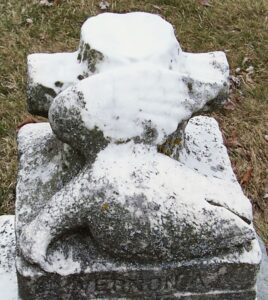
Dead bird symbol.
Lastly, a hummingbird incised on a tombstone.
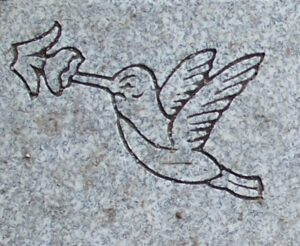
Hummingbird symbol on tombstone.
Nov 11
Today is Veterans Day. A day to thank, honor, and remember our United States veterans.
To all veterans, thank you for your service to our country.
There are some veterans in my immediate family: my uncles, my dad’s brothers, Vernie and Ken Miller, as well as my cousin Ron and nephew Mike.
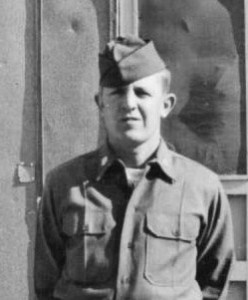
Carl LaVerne “Vernie” Miller, Army Anti Aircraft Artillery
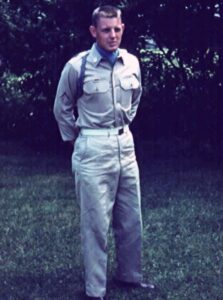
Kenneth Miller, 278 Regimental Combat Team, 1953-55
Thank you for your service.
I have other, more distant relatives who also served, too many to recognize individually because I do not want to inadvertently leave someone out.
Thank you for your service.
I would also like to honor those veterans who have passed, including my dad, Herbert Miller (1925-2012), who was a World War II veteran.
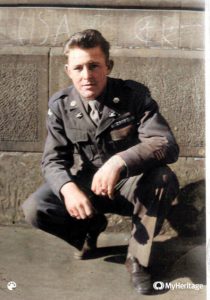
Herbert Miller, WWII, 84th Division, 333rd Company, Infantry, 1944-46.
Veterans Day was originally called Armistice Day and was created to commemorate of the end of World War I. Fighting between the Allied Nations and Germany ceased on the 11th hour of the 11th day of the 11th month in 1918, the date generally regarded as the end of “the war to end all wars.”
Armistice Day became a legal holiday on 11 November 1938, primarily to honor World War I veterans and dedicated to the cause of world peace. After World War II and the Korean War the name was changed to Veterans Day. On 1 June 1954 Veterans Day became a day to honor American veterans of all wars.
Thank a veteran today. They deserve our thanks and gratitude and so much more.